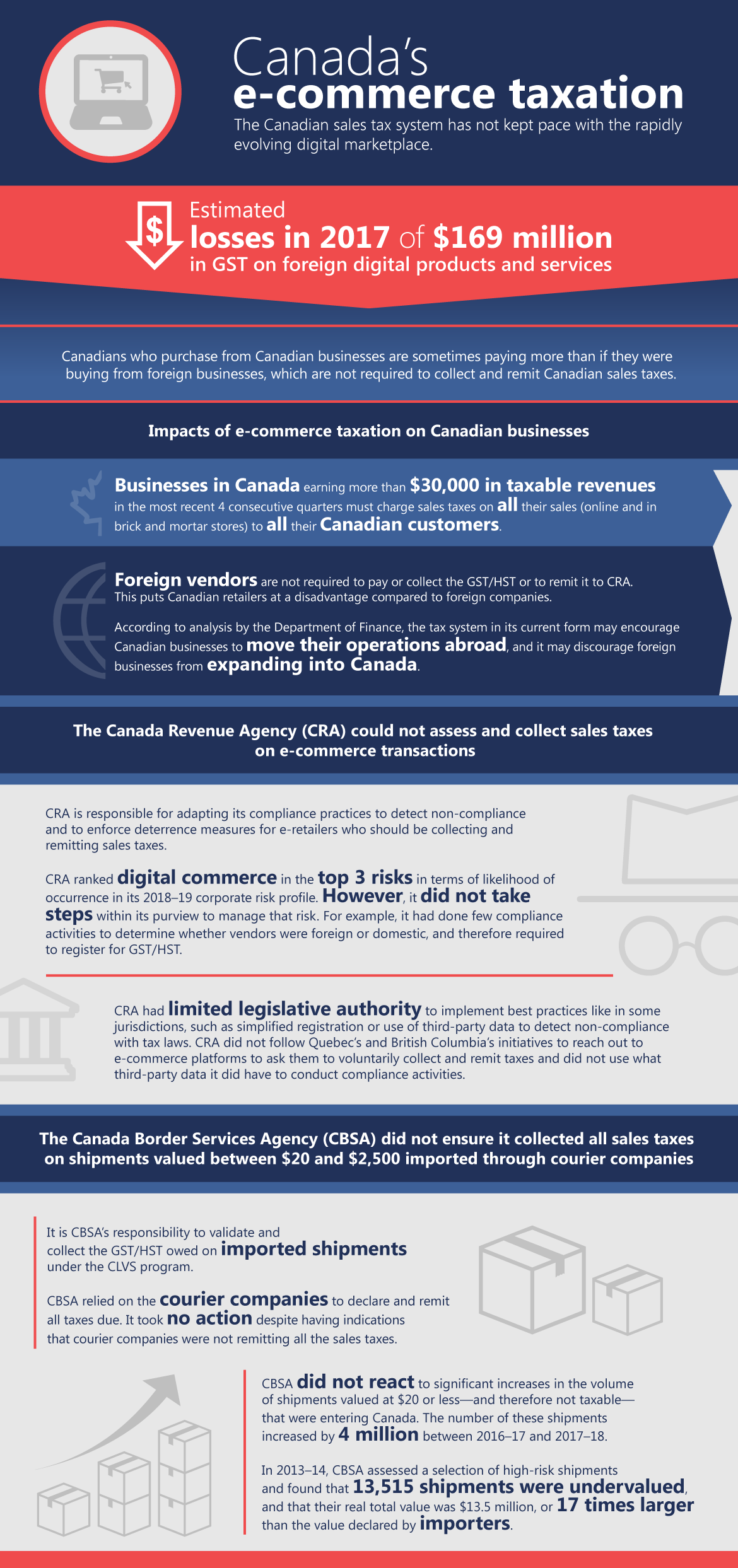Taxation of E-Commerce—Infographic
Taxation of E-commerce—Infographic

Text version
Canada’s e-commerce taxation
The Canadian sales tax system has not kept pace with the rapidly evolving digital marketplace.
Estimated losses in 2017 of $169 million in goods and services taxGST on foreign digital products and services
Canadians who purchase from Canadian businesses are sometimes paying more than if they were buying from foreign businesses, which are not required to collect and remit Canadian sales taxes.
Impacts of e-commerce taxation on Canadian businesses
Businesses in Canada earning more than $30,000 in taxable revenues in the most recent 4 consecutive quarters must charge sales taxes on all their sales (online and in brick and mortar stores) to all their Canadian customers.
Foreign vendors are not required to pay or collect the GST/harmonized sales taxHST or to remit it to Canada Revenue AgencyCRA. This puts Canadian retailers at a disadvantage compared to foreign companies.
According to analysis by the Department of Finance, the tax system in its current form may encourage Canadian businesses to move their operations abroad, and it may discourage foreign businesses from expanding into Canada.
The Canada Revenue Agency (CRA) could not assess and collect sales taxes on e-commerce transactions
CRA is responsible for adapting its compliance practices to detect non-compliance and to enforce deterrence measures for e-retailers who should be collecting and remitting sales taxes.
CRA ranked digital commerce in the top 3 risks in terms of likelihood of occurrence in its 2018–19 corporate risk profile. However, it did not take steps within its purview to manage that risk. For example, it had done few compliance activities to determine whether vendors were foreign or domestic, and therefore required to register for GST/HST.
CRA had limited legislative authority to implement best practices like in some jurisdictions, such as simplified registration or use of third-party data to detect non-compliance with tax laws. CRA did not follow Quebec’s and British Columbia’s initiatives to reach out to e-commerce platforms to ask them to voluntarily collect and remit taxes and did not use what third-party data it did have to conduct compliance activities.
The Canada Border Services Agency (CBSA) did not ensure it collected all sales taxes on shipments valued between $20 and $2,500 imported through courier companies
It is CBSA’s responsibility to validate and collect the GST/HST owed on imported shipments under the Courier Low Value ShipmentCLVS program.
CBSA relied on the courier companies to declare and remit all taxes due. It took no action despite having indications that courier companies were not remitting all the sales taxes.
CBSA did not react to significant increases in the volume of shipments valued at $20 or less—and therefore not taxable—that were entering Canada. The number of these shipments increased by 4 million between 2016–17 and 2017–18.
In 2013–14, CBSA assessed a selection of high-risk shipments and found that 13,515 shipments were undervalued and that their real total value was $13.5 million, or 17 times larger than the value declared by importers.